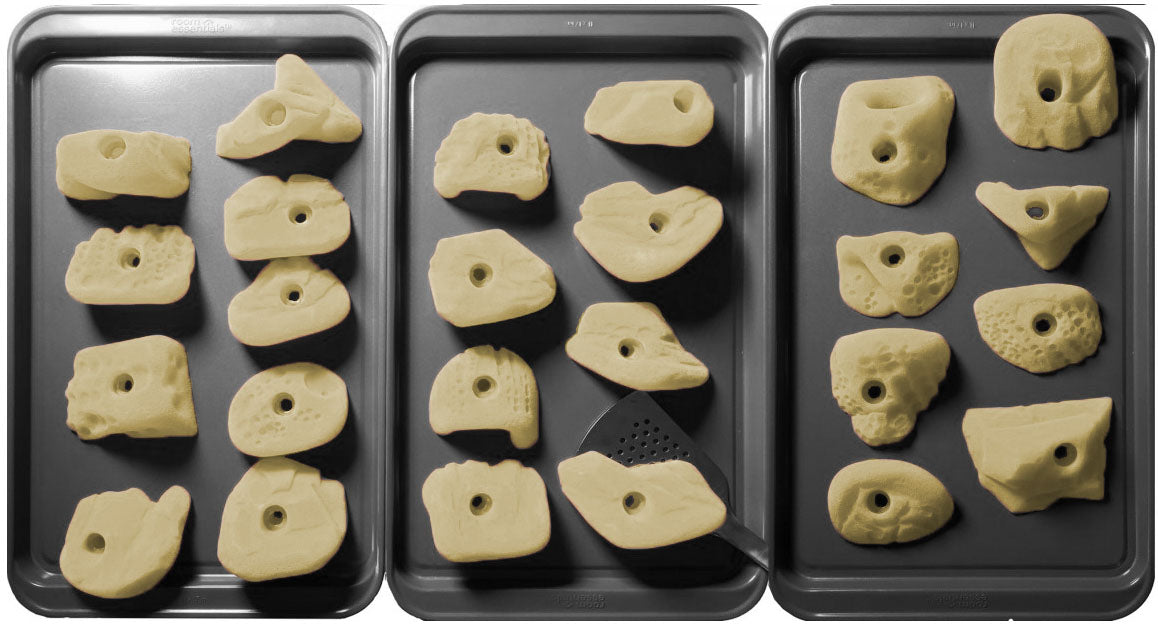5 Essential Types of Climbing Holds for Your Climbing Wall: Complete Product Guide

Every climbing wall needs the right mix of climbing holds to create engaging routes.
But with thousands of hold options available, which types actually matter for your project?
Jugs: The Climber's Best Friend

Jugs are the golden retrievers of the climbing world—friendly, reliable, and always there when you need them. These large, positive holds offer deep edges or bucket-like shapes that accommodate your entire hand comfortably.
You can wrap your fingers around them securely, often getting multiple finger pads on the hold simultaneously.
What makes jugs so appealing is their forgiving nature. They're perfect rest holds where you can hang out, shake out your arms, and plan your next sequence.
For beginners, jugs provide confidence and security while learning fundamental movement patterns. Even experienced climbers appreciate jugs as crucial rest points on challenging routes.
The technique for jugs is straightforward: grab them with your whole hand and use them as stable platforms to set up for more technical moves ahead.
Crimps: Precision and Power Combined

Crimps represent climbing's technical precision. These small, sharp edges require you to curl your fingertips over the hold with your knuckles bent at acute angles.
There are two primary crimping positions: the full crimp (where your thumb wraps over your index finger for extra security) and the half crimp (fingers bent but thumb alongside).
Crimping demands significant finger strength and places considerable stress on your tendons and joints. The key is maintaining proper form—keep your wrists straight and engage your entire kinetic chain from fingers to core.
Many climbing injuries occur from poor crimping technique or overuse, so building finger strength gradually is essential.
These holds often appear on technical face climbs and are crucial for steep, overhanging routes where every point of contact matters. Mastering crimps opens up entire grades of climbing, but patience and progressive training are vital for long-term finger health.
Slopers: The Art of Friction and Body Position
Slopers are climbing's great equalizer, they humble the strong and reward those with excellent technique.
These rounded, often featureless holds rely entirely on friction and body positioning rather than grippable edges. Your palm and fingers must maximize surface contact while your body position creates the optimal angle for adhesion.
The secret to sloper success lies in body positioning and core tension. Keep your hips close to the wall, maintain tension throughout your body, and think about pushing into the hold rather than pulling on it. Your grip should be firm but not death-gripping, as over-gripping actually reduces the surface contact area.
Slopers teach valuable lessons about efficiency and technique over brute strength. They frequently appear as the crux holds on competition routes and outdoor climbs, separating climbers who rely solely on finger strength from those with well-rounded technique.
Pockets: Finger Strength in Isolation

Pockets are holes in the rock that accommodate one, two, or occasionally three fingers. They're common on limestone formations and present unique challenges for finger strength and injury prevention. Single-finger pockets (monos) are particularly demanding and require specific training to use safely.
The technique varies based on pocket size. For two-finger pockets, the middle and ring fingers typically provide the strongest combination, though some climbers prefer index and middle fingers. Three-finger pockets allow for more natural hand positioning but still require careful attention to finger alignment.
Pocket climbing demands respect for your body's limitations. These holds place asymmetrical stress on individual fingers and joints, making them prime candidates for overuse injuries. Progressive training, proper warm-up, and listening to your body are essential when working pocket-heavy routes.
Pinches: Thumb Power and Opposition
Pinches require you to squeeze the hold between your fingers and thumb, like holding a large book. They come in various widths, from narrow pinches that fit in your palm to wide pinches that challenge your thumb's reach and strength. This hold type uniquely engages your thumb and the muscles along the outside of your forearm.
Technique focus should be on creating maximum contact between your thumb and the hold while maintaining finger engagement on the opposite side. Wide pinches often require creative solutions, sometimes using your thumb on one side while multiple fingers work the other edge.
Pinches frequently appear as finishing holds or key moves on bouldering problems. They reward climbers who have developed comprehensive grip strength beyond just finger power. Training pinches improves overall hand strength and teaches valuable lessons about using your thumb effectively in various climbing situations.
Putting It All Together
Understanding these five hold types provides the foundation for reading routes, developing specific strengths, and progressing as a climber. Each hold type teaches different lessons: jugs build confidence, crimps develop precision, slopers emphasize technique, pockets demand respect for your body, and pinches round out grip strength.
The best climbers seamlessly transition between hold types, adapting their technique and energy expenditure accordingly.
They recognize hold types from the ground, plan their approach, and execute with appropriate technique. This recognition and adaptation separate intermediate climbers from advanced ones.
Your Purchase Strategy
-
Start with essentials: Jugs and edges
-
Add progression holds: Slopers and pinches
-
Include specialty items for variety
-
Budget for additions
-
Quality over quantity
Get Started Today
Need help planning your hold selection?
Call 303-447-0512. We'll guide you toward the perfect grip combination for your specific climbing wall.



